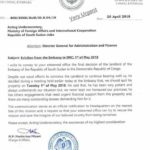Samples of a deadly haemorrhagic fever that killed ten people by February 28 in South Sudan since its outbreak was announced late December 2015, have tested negative for Ebola.
According to a May 19 release dubbed Disease Outbreak News (DONs) by the World Health Organisation (WHO), samples of 33 patients were shipped to WHO collaborating centres at the Uganda Virus Research Institute; the Institut Pasteur of Dakar in Senegal and the National Institute for Communicable Diseases in South Africa but all tested negative for Crimean-Congo haemorrhagic fever, Ebola virus disease, Marburg virus disease, Rift Valley fever, yellow fever, West Nile virus and Zika virus.
Earlier, the National IHR Focal of South Sudan had notified the WHO of an outbreak of the haemorrhagic fever syndrome and as of May 9, a total of 51 suspected cases, including 10 deaths, had been reported from the counties of Aweil North with 45 cases, including 10 deaths and Aweil West with six cases.
The area where the outbreak occurred borders Darfur in Sudan where at least 469 cases of undiagnosed viral haemorrhagic fever, including 120 deaths, were reported between August and November 2015.
However, five samples tested positive for Onyong-nyong virus; three samples were positive for Chikungunya; and one sample tested positive for the dengue virus.
The release further indicates that laboratory results received so far do not explain the symptomatology (unexplained bleeding) of the reported cases nor the high mortality rate.
However, according to the release, currently there is no evidence of person-to-person transmission of the disease and no health care workers have been reported among the cases but the majority (74.5%) of the suspected cases are below 20 years of age.
‘The most frequent symptoms include unexplained bleeding, fever, fatigue, headache and vomiting. The symptoms do not seem to be severe and rapidly resolve following supportive treatment’ a release by the WHO states.
The fever has been attributed to the frequent cross-border movement between Sudan and South Sudan, and according to WHO the risk of international spread of the disease cannot be ruled out.







